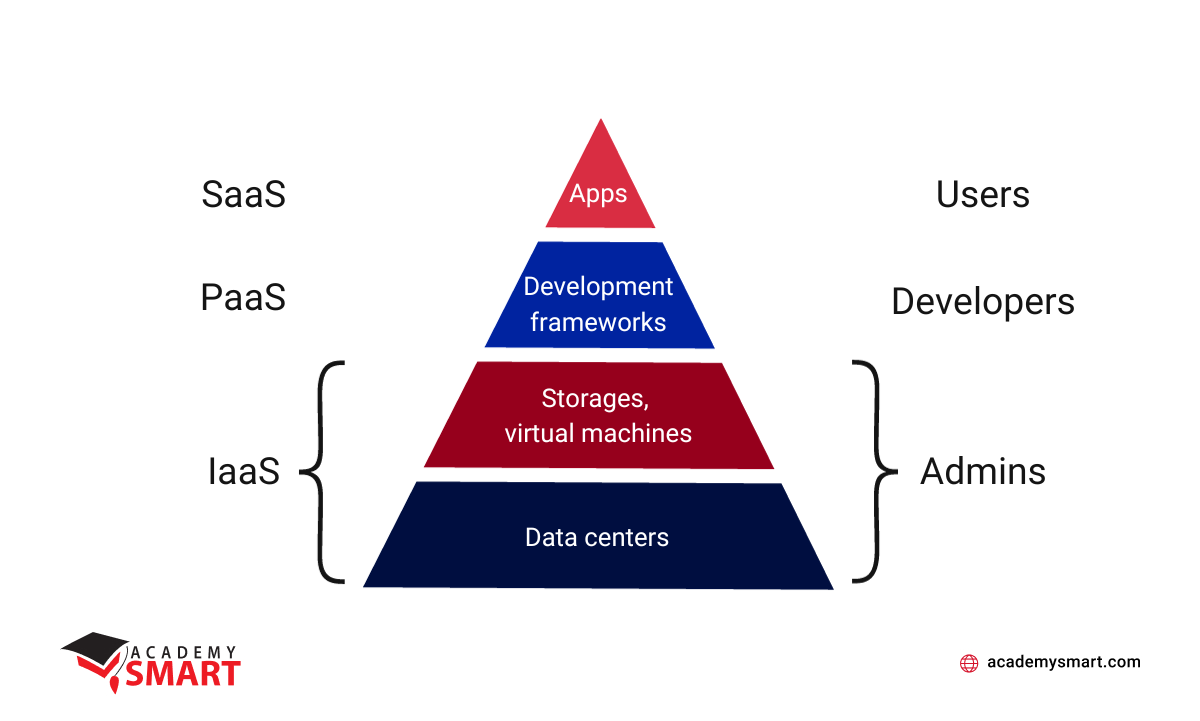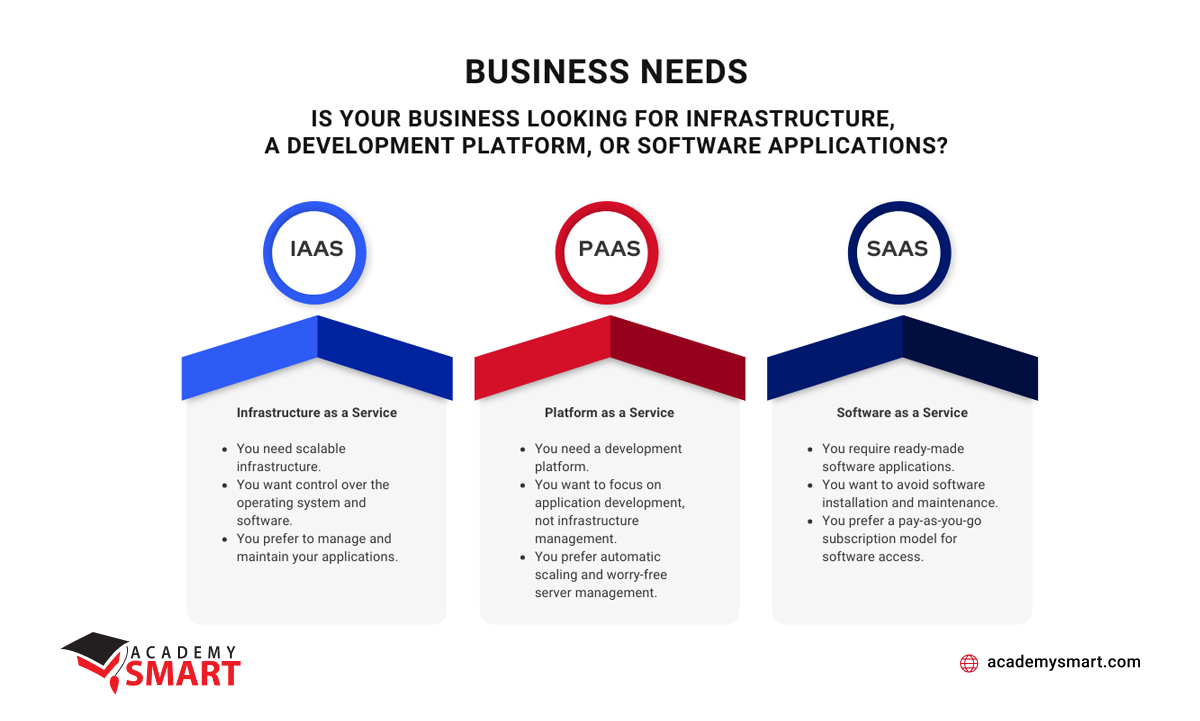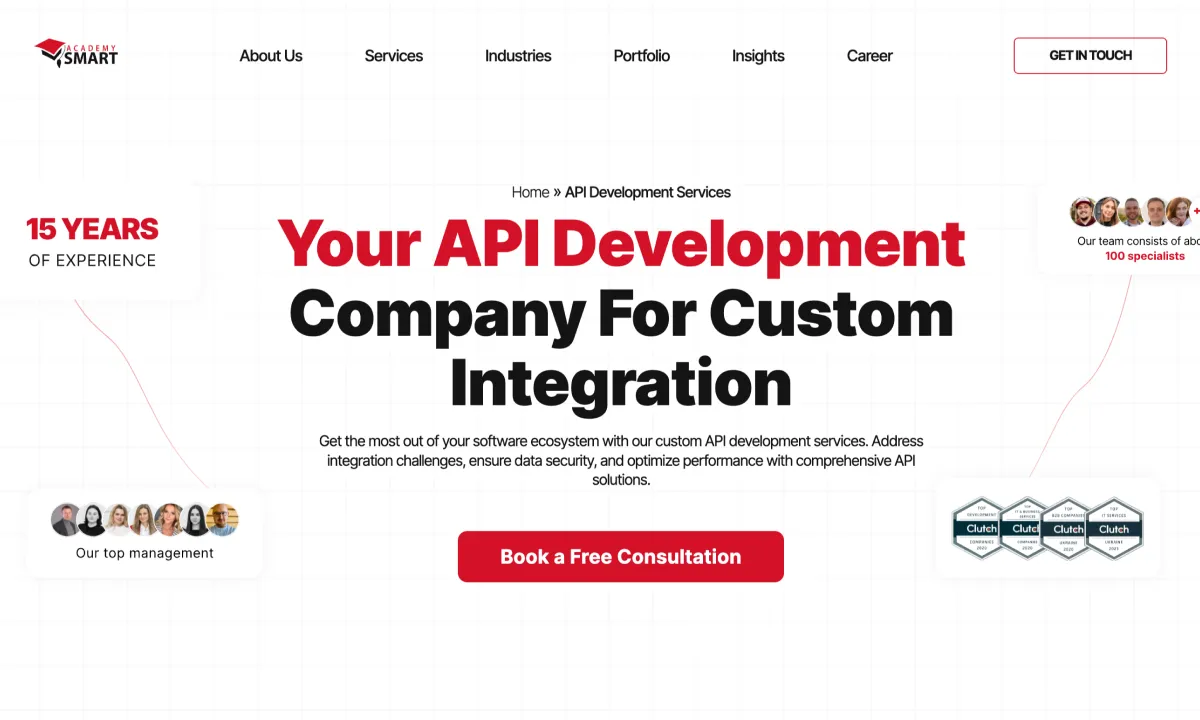
Architecture Layers of Cloud Computing
Contents
The concept of cloud computing has become an integral force, reshaping the way organizations operate and innovate. Cloud computing is based on a multi-layered architecture, each layer serving a unique purpose in delivering seamless and efficient services. Understanding their essence and pursuit makes choosing the right tools to achieve business goals possible. This article introduces you to the basics of this issue.
Cloud Layers Definition
Cloud computing is a paradigm that leverages the power of the internet to deliver a wide range of computing assistance on-demand and as a service. Instead of relying on local servers or personal computers for data storage and processing, it utilizes a network of remote servers, often hosted by third-party providers, to handle various computing needs. Essential differences of this approach are presented more deeply in the post “In-House Servers vs Cloud Computing: What to Prefer?“
Cloud services are accessible over the internet from various devices, providing users ubiquitous access to computing resources and applications. Cloud providers dynamically prepare and allocate computing resources to multiple users, optimizing their utilization. Computational power can be quickly scaled up or down based on demand. Besides, сloud services are metered, and users are billed based on usage.
In essence, the cloud computing model relies on a multi-layered architecture that includes hardware and software components to provide the benefits of service flexibility and scalability. Why is this solution successful?
- The layered architecture abstracts the complexities of the underlying infrastructure. Each layer represents a level of abstraction, allowing users and developers to interact with the system without needing an in-depth understanding of the entire infrastructure. This abstraction simplifies the user experience and facilitates easier management.
- Each layer in the architecture is designed to perform specific functions, creating a modular and specialized environment. This specialization enhances the efficiency of any layer in handling its designated tasks, promoting a more streamlined and optimized operation.
- The layered approach supports scalability by enabling individual layers to scale independently. Resources can be allocated and expanded at the specific layer where increased capacity is needed without affecting other layers. It provides a flexible and responsive solution to handle varying workloads.
- Layers communicate through well-defined interfaces, promoting interoperability. This standardized communication ensures that different layers can work together seamlessly, fostering compatibility and avoiding conflicts. It facilitates the integration of diverse technologies and services.
- The separation of layers simplifies maintenance and updates. Changes can be made to one layer without significantly impacting others, reducing the risk of disruptions to the entire system. This modularity enhances the overall reliability and stability of the cloud infrastructure.
- Security measures can be implemented at each layer, addressing specific threats and vulnerabilities associated with that layer. This defense-in-depth approach ensures that even if one layer faces a security challenge, other layers remain secure. It adds a layer of protection against potential breaches.
- Layers provide users with customization options based on their specific needs. Users can leverage the services and capabilities offered by each layer according to their requirements. This flexibility empowers users to tailor their cloud experience to meet business objectives.
- The layered architecture accommodates technological advancements without disrupting the entire system. As technology evolves, new layers or updates to existing layers can be implemented, ensuring that the cloud infrastructure remains adaptable and future-proof.
In the most general sense, we can distinguish the following layers of cloud architecture:
- Physical layer
The tangible hardware foundation, like servers and data centers. - Network layer
The communication hub, connecting the physical infrastructure with routers and switches. - Compute layer
The technological brain, utilizing virtualized servers to execute applications. - Storage layer
The digital storage hub, managing data efficiently with various storage solutions. - Platform layer
An operational workshop, providing tools for building and managing cloud applications. - Application layer
The pinnacle of user interaction, hosting both custom and third-party applications.
As these layers must interact seamlessly, there arises a need for a unified guidebook. The cloud reference model typically executes this role, setting standards or frameworks that define the structure, components, and interactions within the cloud computing environment. Commonly, cloud reference models include considerations for different layers of demand cloud services, such as Infrastructure-as-a-Service (IaaS), Platform-as-a-Service (PaaS), and Software-as-a-Service (SaaS). Additionally, they may outline the roles and interactions of various stakeholders, including cloud consumers, providers, auditors, and brokers.

Layers of cloud computing
Main Layers in Cloud Computing
Three cloud computing layers are usually associated with the main types of cloud services: IaaS, PaaS, and SaaS. What are cloud layers your enterprise may utilize?
Infrastructure services layer
The cloud IT infrastructure layer, or Infrastructure as a Service, forms the foundational component of cloud computing. It operates as a virtualization coating, employing technologies like Xen, KVM, Hyper-V, and VMware to partition physical resources into a pool of virtualized compute and storage resources. IaaS acts as the central hub within the cloud environment, where resources are continually added through various virtualization techniques.
The infrastructure services layer provides the fundamental building blocks for scalable and flexible IT infrastructure. It manages physical resources such as servers, switches, routers, power supplies, and cooling systems in a data center environment. Moreover, it encompasses virtualized computing power, including servers, storage, and networking. IaaS facilitates decoupling business logic from persistent data, supporting microservices architecture, and reducing interdependencies in software application designs. Virtualization allows IaaS vendors to achieve high utilization rates, often up to 90%, optimizing computing resources. IaaS is the base for creating the platform layer.
This cloud model, presented by AWS, Google Cloud, and Microsoft Azure services, offers advantages such as cost savings, on-demand scalability, and increased efficiency. Adopting IaaS empowers businesses to focus on core operations while adapting rapidly to changing business needs in cloud computing leveraging.
Platform services layer
The platform layer constitutes a specific level in cloud computing, encompassing the operating system and application software. Its primary objective is to offer users a robust foundation for deploying and managing applications with a focus on scalability, dependability, and security. This layer serves as the bedrock for implementing SaaS applications by providing a space for users to create, test, and monitor applications.
At its core, the PaaS is constructed upon the infrastructure layer, leveraging virtualized network, storage, and computing resources. This layer simplifies the deployment of applications by abstracting the complexities of direct interaction with virtual machines. In practical terms, popular platforms like AWS Elastic Beanstalk, AWS App Runner, Google App Engine, or AWS Amplify operate within this layer, furnishing API support for storage, databases, and business logic in web applications.
Unlike infrastructure-oriented clouds, the platform services layer provides a scalable environment for creating and hosting web applications, enabling developers to construct and deploy applications without intricate knowledge of underlying hardware specifications.
The key features of the Platform-as-a-Service include:
- granting cloud providers complete control over service provisioning;
- allowing consumers selective control over resources;
- providing user-friendly environments for application development;
- ensuring scalability and security;
- delivering services for creating workflows and connecting to external platforms.
Application services layer
This layer, positioned at the pinnacle of the cloud computing stack, represents the domain where actual cloud applications reside. In contrast to traditional applications, cloud applications harness automatic scaling functionalities, delivering heightened performance, increased availability, and reduced operational costs. This layer encompasses various cloud services tailored to meet the diverse needs of business cloud users.
For effective data transfer, the application layer assesses the availability of communication partners and ensures adequate cloud resources for seamless transmission. The coordination of apps for communication falls under its jurisdiction. Specifically, the application layer manages the processing of IP traffic handling protocols like Telnet and FTP. Notable examples of systems operating at the application layer include web browsers, SNMP protocols, HTTP protocols, and HTTPS.
In the Software-as-a-Service context, this layer signifies the delivery of ready-to-use applications accessible over the Internet. Users benefit from the convenience of accessing software applications without needing local installations. SaaS spans a spectrum of applications, from productivity suites to supply chain management systems, offering scalability, flexibility, and easy accessibility. Businesses leveraging SaaS can streamline operations, enhance collaboration, and focus on core competencies while relying on secure cloud-based solutions.
SaaS is the layer most familiar to users, involving web-based logins to access tools or services. This subscription-based model offers flexibility in adding or subtracting users as needed, with the provider handling software upgrades, support, and uptime. SaaS applications can be integrated for customized use, promoting easy entry, startup, and seamless collaboration.
In essence, the application services layer represents the culmination of cloud computing, providing enterprise users with the substantial benefits of advanced functionalities, accessibility, and collaborative potential inherent in cloud applications.

Business application of cloud computing layers
Improve Your Cloud Layers of IT infrastructure with Academy Smart
With 14 years of expertise, we specialize in crafting customized cloud applications for enterprises and facilitating seamless transitions to cloud-based business operations.
Our team comprises skilled professionals, including programmers, native cloud application engineers, DevOps specialists, business analysts, and project managers. Explore our services, from custom turnkey software development to remote IT employee staff augmentation.
Contact us to fortify your team and enhance your cloud capabilities.
Frequently Asked Questions: Cloud Computing Layers
What are the benefits of using cloud computing layers?
- enhanced scalability and flexibility;
- streamlined resource management;
- cost savings through pay-as-you-go models;
- simplified infrastructure maintenance.
What are some business applications of cloud computing layers?
Cloud computing layers find applications in various business domains, facilitating scalable IT infrastructure, platform-based development, and accessible software services, enabling businesses to optimize resource utilization, enhance collaboration, and simplify operations.
Book a free consultation

Reach out to start talking today!










